MARIJUANA, HASHISH, CANNABIS AND HEMP
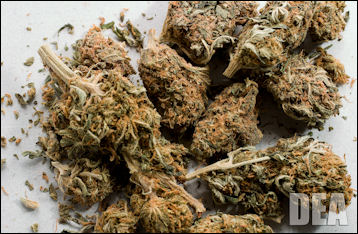
The cannabis plant is the source of source of the recreational drugs marijuana and hashish and the tough fiber hemp. Marijuana refers to the dried buds and leaves of some kinds of cannabis plants while hashish refers to resin or compressed resin glands derived from the same kinds of plants. In Britain and Europe, marijuana is called cannabis. Cannabis is also the word used today for intoxicating products from the cannabis plant, including marijuana and hashish. Hemp, used in making ropes and clothes, is derived from the cannabis plant’s stalks. The word cannabis is probably Semitic, and possibly Hebrew, in origin, and is associated with words used by the ancient Sumerians and Scythians and terms found in the Bible.
It is widely accepted that cannabis originated in Central Asia, with some evidence that this general area extends into the northern parts of South Asia. The exact number of species within the genus cannabis is disputed but there are two subspecies of the plant — Cannabis Sativa and Cannabis Indica — and four varieties. Cannabis grows in almost every country in the world and can flourish in a variety of climates, soils and areas.
Smoked and consumed about everywhere, cannabis is regarded as second most widely used intoxicants in the world after alcohol and the most widely produced, trafficked and consumed illegal drug.
See Separate Articles HASHISH: HISTORY, TYPES AND PRODUCTION factsanddetails.com ; CANNABIS (MARIJUANA) HEALTH AND LAWS factsanddetails.com ; CANNABIS PRODUCTION: THE PLANT, AGRICULTURE AND ERADICATION EFFORTS factsanddetails.com
Websites and Resources: U.S. Drug Enforcement Administration (DEA) justice.gov/dea/concern ; Vaults of Erowid erowid.org ; United Nations Office of Drugs and Crime (UNODC) unodc.org ; Wikipedia article on illegal drug trade Wikipedia ; Frank’s A-to-Z on Drugs talktofrank.com ; Streetdrugs.org streetdrugs.org ; Illegal Drugs, country by country listing, CIA cia.gov/library/publications/the-world-factbook
Books: “Buzzed” by Cynthia Kuhn Ph.D. Scott Swartzwelder, Ph.D., Wilkie Wilson Ph.D. of the Duke University Medical Center (Norton, 2003); “Consuming Habits: Drugs in Anthropology and History” by Goodman, Sharratt and Lovejoy; “Drug War Heresies: Learning from Other Vices, Times and Places” by Robert MacCoun and Peter Reuter (Cambridge University Press).
THC and Active Ingredient in Cannabis
Δ9-THC (delta-9-tetrahydrocannabinol) is the main active ingredient in cannabis, marijuana and hashish that provides the psychoactive effects and makes people get high. Found in resin produced by the leaves and buds primarily of the female cannabis plant, it was discovered in 1964 by Raphael Mechoulam of the Hebrew University in Jerusalem. In the 1980s, Mechoulam was the first to isolate similar chemicals — fatty acids he called anandamides — produced in the human brain.
THC and anandamides — named after the Sanskrit word for "bliss” (“ananda” ) “belong to a the family of chemical called cannabinoids. Exactly what anandamides do in the human body is unclear but they are believed to play a role in memory, movement control and pain sensitivity. Studies have shown that cannabinoids play a major role regulating body weight and appetite. One study found that mice who were unable to process cannabinoids ate less than normal mice.
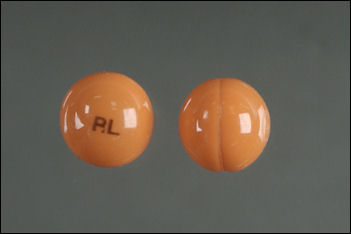
marinol The plant also contains more than 500 other chemicals, including more than 100 compounds that are chemically related to THC, called cannabinoids or cannabinoid-like. Some are called cannabidioils and cannabinols. Among these are 120 unique compounds, known collectively as phytocannabinoids. Little is known about what they do. THC is significant because it is both psychoactive and found in large amounts. A few other cannabinoids are as potent as THC but they found in smaller amounts and in only a few varieties of the cannabis plant.
According to RTT News: “Cannabidiol or CBD is also a naturally-occurring cannabinoid constituent of cannabis. It is a chemical in the cannabis plant often used for medicinal purposes, and does not have the intoxicating effects like those caused by THC As CBD is believed to relieve or ease symptoms related to health problems, CBD-infused products such as beer, iced tea, jelly beans and ice cream are flooding the market. The CBD industry is expected to be a $20 billion industry by 2022.” [Source: RTT News]
Cannabis Users
Cannabis is the most commonly used recreational drug after tobacco and alcohol. Its use is widespread among young people. Users often have a sleepy, dopey look; red, blood-shot eyes; heavy eyelids and a dry mouth. Most marijuana and hashish users get high no more than once a week. Almost half of users use it less than 10 times a year. In most Western countries, surveys show that about a third of the people between 15 and 50 have tried cannabis at least once and 10 to 15 percent are regular users (the definition of a regular user varies quit a bit). Only 9 to 12 percent of cannabis users are regarded as dependent. By contrast 80 percent of nicotine users are. Many cannabis users say that marijuana and hashish are less harmful and addictive than coffee.
The UNODC's World Drug Report 2021 estimated there are 200 million cannabis users worldwide. Global prevalence of cannabis use has increased modestly while the number of cannabis users continues to rise Cannabis continues to be the most widely used drug worldwide. UNODC estimates that almost 4 per cent (range: 2.8–5.1 per cent) of the global population aged 15–64 years used cannabis at least once in 2019, the equivalent of some 200 million people (range: 141 million–256 million). The overall number of people who used cannabis in the past year is estimated to have increased by nearly 18 per cent over the past 10 years (2010–2019), reflecting in part an increase in the global population of 10 per cent over the same period. [Source: United Nations Office on Drugs and Crime (UNODC), World Drug Report 2021]
According to the World Drug Report 2018: Cannabis was the most widely consumed drug in 2016, with 192 million people using it at least once during the previous year. The global number of cannabis users continues to rise and appears to have increased by roughly 16 per cent in the decade to 2016, reflecting a similar increase in the world population. [Source: World Drug Report 2018,United Nations Office on Drugs and Crime (UNODC), June 26, 2018]
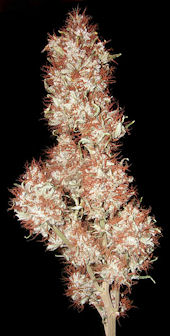
Bullrider cannabis
In the United States: Among people aged 12 or older in 2020, 17.9 percent (or about 49.6 million people) reported using cannabis in the past 12 months. In 2021, an estimated 7.1 percent of 8th graders, 17.3 percent of 10th graders, and 30.5 percent of 12th graders reported using cannabis in the past 12 months. Among people aged 12 or older in 2020, an estimated 5.1 percent (or about 14.2 million people) had a cannabis use disorder in the past 12 months. [Sources: 2020 National Survey on Drug Use and Health; 2021 Monitoring the Future Survey]
In 2018, more than 11.8 million young adults used cannabis in the past year in the U.S. According to the Monitoring the Future survey, rates of past year cannabis use among middle and high school students have remained steady, but the number of teens in 8th and 10th grades who say they use it daily has increased. With the growing popularity of vaping devices, teens have started vaping THC (the ingredient in cannabis that produces the high), with nearly 4 percent of 12th graders saying they vape THC daily. In addition, the number of young people who believe regular cannabis use is risky is decreasing. Legalization of cannabis for medical use or adult recreational use in a growing number of states may affect these views.[Source: National Institute on Drug Abuse, National Institutes of Health, U.S. Department of Health and Human Services, December 2019]
In the United States in the late 2000s, about 47 percent of the adult population has tried cannabis and six percent said they smoked it regularly in surveys 2002 and 2006. Many tend to smoke it in their teens and quit in their 20s. Fifty percent don’t use any other drug. According to the United Nations annual report on drugs, issued in June 2009, global use of cannabis fell in 2008. At that time consumption of cannabis had dropped in the developed world, especially among young people. However the amount of THC in the cannabis sold has almost doubled in the 10 previous years. An estimated 160 million people used cannabis in 2003, an increase of 10 million from the previous year. About 10,000 metric tons of it was consumed every year at that time in the United States alone.
Getting High on Cannabis
Cannabis products can be smoked, eaten or mixed with drinks. They cannot be injected because the materials are not very soluble in water as is the case with morphine, heroin and cocaine. . The chemical compounds responsible for getting people high are found mainly in the sticky resins exuded from the female cannabis plant. People can mix cannabis in food (edibles), such as brownies, cookies, or candy, or brew it as a tea. A newly popular method of use is smoking or eating different forms of THC-rich resins.
When a person smokes cannabis, THC quickly passes from the lungs into the bloodstream. The blood carries the chemical to the brain and other organs throughout the body. The body absorbs THC more slowly when the person eats or drinks it. In that case, they generally feel the effects after 30 minutes to 1 hour. THC acts on specific brain cell receptors that ordinarily react to natural THC-like chemicals. These natural chemicals play a role in normal brain development and function. [Source: National Institute on Drug Abuse, National Institutes of Health, U.S. Department of Health and Human Services, December 2019]
Cannabis over activates parts of the brain that contain the highest number of these receptors. This causes the "high" that people feel. Other effects include: 1) altered senses (for example, seeing brighter colors); 1) altered sense of time; 2) changes in mood; 3) impaired body movement; 4) difficulty with thinking and problem-solving; 5) impaired memory; 6 ) hallucinations (when taken in high doses); 7) delusions (when taken in high doses); 8) psychosis (risk is highest with regular use of high potency cannabis)
People who get high often feel giddy, laugh uncontrollably about silly things, engage in animated conversations, get lost in their own thoughts or intensely get into listening to music, watching a film or contemplating nature. Cannabis generally has a sedative effect and makes people feel relaxed although that is not always the case. Some people feel stimulated and energetic and say that time is distorted. After the initial buzz begins to wear off, some people get very hungry (the munchies) and feel fatigued and sleepy.
People who are high sometimes get anxious if they are thrown into a situation that they are not completely comfortable with. People who are not used to getting high often feel uncomfortably strange and sometimes get panicky. In some extreme cases they freak out and need to be gently comforted to regain their composure. Some people claim that getting high greatly improves sex. Other say it promotes creativity and heightens their perceptions, making things seem more profound. It is debatable whether these experiences are more meaningful or the user is simply deluding himself. Often time users have difficultly remembering what and why things seemed so profound after they come down.
Pleasant experiences with cannabis are by no means universal. Instead of relaxation and euphoria, some people experience anxiety, fear, distrust, or panic. These effects are more common when a person takes too much, the cannabis has an unexpectedly high potency, or the person is inexperienced. People who have taken large doses of cannabis may experience an acute psychosis, which includes hallucinations, delusions, and a loss of the sense of personal identity. These unpleasant but temporary reactions are distinct from longer-lasting psychotic disorders. Although detectable amounts of THC may remain in the body for days or even weeks after use, the noticeable effects of smoked cannabis generally last from 1 to 3 hours, and those of cannabis consumed in food or drink may last for many hours. Eating or drinking cannabis delivers significantly less THC into the bloodstream than smoking an equivalent amount of the plant. Because of the delayed effects, people may inadvertently consume more THC than they intend to. [Source: National Institute on Drug Abuse, National Institutes of Health, U.S. Department of Health and Human Services, July 2020]
Smoking Cannabis
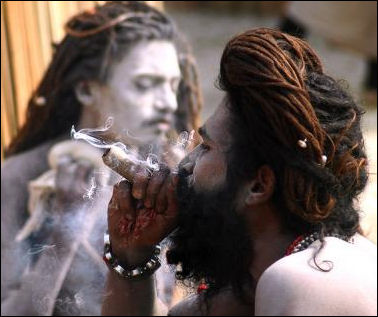
Indian holy men smoking charas People smoke cannabis in hand-rolled cigarettes (joints) or in pipes or water pipes. They also smoke it in blunts — emptied cigars that have been partly or completely refilled with cannabis. To avoid inhaling smoke, some people are using vaporizers. These devices pull the active ingredients (including THC) from the cannabis and collect their vapor in a storage unit. A person then inhales the vapor, not the smoke. Some vaporizers use a liquid cannabis extract. [Source: National Institute on Drug Abuse, National Institutes of Health, U.S. Department of Health and Human Services, December 2019]
Cannabis and hashish smokers in Europe like to roll joints with tobacco mixed in the cannabis. Americans prefer joints without tobacco and like to smoke the stuff in pipes or take single hits in tubular water pipes called a bongs.
As is true with nicotine in cigarettes, smoking is the quickest way for THC to be absorbed in the blood and the brain. Some people eat cannabis products but this is regarded as a less efficient way of getting THC to the brain. Absorption rates vary greatly from person to person, depends on how much a person ate beforehand (an empty stomach is preferable) and sometimes requiring three or four hours for drug to reach peak levels.
The method of smoking has an impact on how the drug is absorbed. Cigarettes transfer about 10 to 20 percent of the THC. Pipes are much efficient, transferring 40 to 50 percent. Water pipes are the most efficient of all since the pipe traps the smoke until it is inhaled.
When someone smokes cannabis the smoke goes into the lungs where it is absorbed quickly into the blood in the lung sacs. From there the bloods takes the THC quickly to heart, brain and other parts of the body. Although the THC disappears from the brain after a few hours it remains in other organs and the blood for hours or even days after the person last lit up and sometimes has a lingering, low-level psychoactive effect. Some THC is absorbed by body fats and can remain there for weeks, and can be picked up in drugs test months after a person has smoked.
How THC Gets You High
THC is mildly hallucinogenic and probably interacts with many chemical pathways. Its chemical structure is similar to the brain chemical anandamide. Similarity in structure allows drugs to be recognized by the body and to alter normal brain communication. Endogenous cannabinoids such as anandamide function as neurotransmitters because they send chemical messages between nerve cells (neurons) throughout the nervous system. They affect brain areas that influence pleasure, memory, thinking, concentration, movement, coordination, and sensory and time perception. Because of this similarity, THC is able to attach to molecules called cannabinoid receptors on neurons in these brain areas and activate them, disrupting various mental and physical functions and causing the effects described earlier. The neural communication network that uses these cannabinoid neurotransmitters, known as the endocannabinoid system, plays a critical role in the nervous system’s normal functioning, so interfering with it can have profound effects. [Source: National Institute on Drug Abuse, National Institutes of Health, U.S. Department of Health and Human Services, July 2020]
For example, THC is able to alter the functioning of the hippocampus and orbitofrontal cortex, brain areas that enable a person to form new memories and shift his or her attentional focus. As a result, using cannabis causes impaired thinking and interferes with a person’s ability to learn and perform complicated tasks. THC also disrupts functioning of the cerebellum and basal ganglia, brain areas that regulate balance, posture, coordination, and reaction time. This is the reason people who have used cannabis may not be able to drive safely and may have problems playing sports or engaging in other physical activities.
THC, acting through cannabinoid receptors, also activates the brain’s reward system, which includes regions that govern the response to healthy pleasurable behaviors such as sex and eating. Like most other drugs that people misuse, THC stimulates neurons in the reward system to release the signaling chemical dopamine at levels higher than typically observed in response to natural rewarding stimuli. The surge of dopamine “teaches” the brain to repeat the rewarding behavior, helping account for cannabis’s addictive properties.
Early History of Cannabis

The cannabis plant is native to Asia and still grows wild over large areas of China, India, Central Asia, and Southeast Asia. It is thought to have originated in mountainous areas north and west of the Himalayas but is now found in most parts of the world. Charred hemp seed dated to the Neolithic Age have been found ritual braziers in Romania. At least by 4000 B.C. and maybe as early as 10,000 B.C. the Chinese used cannabis in fabrics and foods and as a medicine and may have used it is an intoxicant. It was cultivated in Central Asia at least by 3000 B.C.
It is believed that cannabis originated in present-day Central Asia, and that humans began to utilize it as early as 10,000 B.C. Cannabis was probably originally utilised for fibre and seed, with its medicinal and psychoactive properties being discovered later. By around 500 B.C. nomadic Scythian tribes that inhabited the region were well-known for their cannabis use. A Scythian tomb site (‘barrow’) dated to around 300 B.C. was found in Mongolia’s Western Altai region and excavated in 1929. It contained the embalmed body of a man along with a cauldron full of burnt hemp seeds. Another barrow dated to around 400-500 B.C. and excavated in 1947-1949, contained various cauldrons and flasks containing burnt and unburnt cannabis seeds.[Source: Sesheta, August 28, 2014, Sensi Seeds sensiseeds.com -]
There are reference to a legendary Chinese emperor who used cannabis as a treatment for malaria, gout, constipation, rheumatism, “absentmindedness” and “female disorders” in 2700 B.C. A Chinese herbalist around the same time recommended it for insomnia, dysentery, venereal disease and headaches. The ancient drug “soma” mentioned in the ancient Hindu “Vedas” is thought to have been cannabis. In ancient Hindu legends, followers of Shiva are taught to revere he cannabis plant and holymen who follow Shiva have traditionally smoked copious amounts of marijuana and hashish as spiritual aids.
The Scythians — an Indo-Iranian horse people who migrated from Central Asia to the European Steppe north of the Black Sea around 700 B.C. — were reportedly quite found of cannabis. Herodotus wrote that for entertainment they threw cannabis onto heated stones, creating "a strong aroma that no Greek burnt offering can match" and causing “the horsemen too dance and howl in their joy." In one tomb archeologists found a skull with three small holes (believed to have been drilled to relieve swelling) and a cache of marijuana to offer relief from pain in the hereafter.
World's Oldest Marijuana Found in Northwest China
Nearly a kilogram of still-green marijuana was found in a 2,700-year-old near Turpan in northwest China. Jennifer Viegas of NBC News wrote: “Nearly two pounds of still-green plant material found in a 2,700-year-old grave in the Gobi Desert has just been identified as the world's oldest marijuana stash, according to a paper in the latest issue of the Journal of Experimental Botany. A barrage of tests proves the marijuana possessed potent psychoactive properties and casts doubt on the theory that the ancients only grew the plant for hemp in order to make clothing, rope and other objects. [Source: Jennifer Viegas, NBC News, December 3, 2008 =]
“They apparently were getting high too. Lead author Ethan Russo told Discovery News that the marijuana "is quite similar" to what's grown today. "We know from both the chemical analysis and genetics that it could produce THC (tetrahydrocannabinolic acid synthase, the main psychoactive chemical in the plant)," he explained, adding that no one could feel its effects today, due to decomposition over the millennia. =
“Russo served as a visiting professor at the Chinese Academy of Sciences Institute of Botany while conducting the study. He and his international team analyzed the cannabis, which was excavated at the Yanghai Tombs near Turpan, China. It was found lightly pounded in a wooden bowl in a leather basket near the head of a blue-eyed Caucasian man who died when he was about 45. "This individual was buried with an unusual number of high value, rare items," Russo said, mentioning that the objects included a make-up bag, bridles, pots, archery equipment and a kongou harp. The researchers believe the individual was a shaman from the Gushi people, who spoke a now-extinct language called Tocharian that was similar to Celtic. =
See Separate Article FOOD, DRINKS AND CANNABIS IN ANCIENT CHINA factsanddetails.com
Ritual Cannabis-Opium Potions in Ancient Central Asia?
Margiana (50 miles north of Merv, Turkmenistan) is the site of a Bronze Age civilization that thrived around the 2nd millennium B.C. and ranks with ancient Egypt, Mesopotamia and the Indus Valley as one of the world’s oldest civilizations. Its inhabitants built mud-wall fortresses and crafted bronze seals, lovely ceramics, jewelry and ceremonial items and drank a potion made with opium, cannabis and ephedra plants. Some historians believe that Zoroaster may have lived here. [Source: New York Times]

ancient Greek vessel perhaps with a cannabis image Oxus or Bactria-Margiana civilisation, which was at its peak from around 2300 to 1700 B.C. in parts of preset-day Turkmenistan, produced pottery with what some have said are impressions made by hemp seeds, but this conclusion has been disputed. According to Sensi Seeds:“The Russian archaeologist Viktor Sarianidi (1929-2013) discovered the remnants of the Oxus civilisation during excavations near the Oxus River (Amu Darya) in 1976, and was the source for the claim that traces of cannabis were found in pottery stored in rooms apparently intended for purposes of ritual worship. It is thought that the religion of the civilisation was a form of fire-worship that later developed into Zoroastrianism, the official religion of the Persian Empire. He claimed that cannabis (along with opium and ephedra, other entheogenic plants indigenous to the region) was used to make an intoxicating beverage, known as haoma to the Zoroastrians and soma to the Vedic priests of India. He also observed modern cannabis plants growing in the vicinity of the temples. [Source: Seshata, September 30, 2014, Sensi Seeds sensiseeds.com -]
“According to Sarianidi, three ceramic bowls with traces of cannabis and ephedra were discovered, as well as a basin containing a considerable quantity of cannabis, and several items apparently used for extracting and straining the juices from the plants. It was reported that analysis of the samples confirmed the presence of cannabis and ephedra. The ceramic pots also contained layers of gypsum that had settled over the years and retained the impressions of small seeds stated to be from the hemp plant.-
See Separate Article BACTRIA MARGIANA (OXUS CIVILIZATION) AND EARLY CENTRAL ASIAN POLITIES factsanddetails.com
Cannabis in the Ancient World
Cannabis was mentioned by Greco-Roman-era physician Galen and was used by tribes in Africa to treat snakebites and relieve pain during childbirth. The ancient Persians made huge bonfires with cannabis plants that intoxicated people who breathed in the smoke and fumes.
Traces of THC have been identified in an Egyptian mummy dated to 950 B.C. Archaeologists in Israel unearthed remains of teenage girl, dated to the A.D. 315, who had the remains of a fetus in her abdomen and ash containing THC near her body. The archeologists speculate that maybe cannabis was given to the girl as pain relief.
By around A.D. 1000, cannabis was widely used as an intoxicant in the Middle East. The word assassin was derived from the word "hashishim" or "taker of hashish" and was used to describe a 11th century Persian sect whose members were drugged with hashish wine and then taken to a lush valley where all of their sexual desires were fulfilled to gain their loyalty to carry out assassinations and suicide attacks. Hashish has long been used in the Islamic world and is thought to have been used by — but frowned upon — by Sufi mystics as a spiritual aid.
Later History of Cannabis
Cannabis spread from Asia and the Middle East to other parts of the world. In Europe and Asia, hemp fibers were used as textile fibers for coarse cloth, rope, and ship sails. The word "canvas" is believed to have been derived from the word "cannabis." The pilgrims, the colonists at Jamestown and George Washington and Thomas Jefferson grew it for fiber on plantations.
In 19th century Nepal the cannabis harvest was performed by naked men who ran through fields of flowering plants. The sticky resin was scraped off their bodies and formed into blocks of hashish. Some believe Zulu fighters in South Africa were high of dagga (cannabis) when they attacked the Boers at Blood River in 1838. The Zulus lost 3,000 fighters, while only four Boer were wounded.

scene from Reefer Madness Cannabis as an intoxicant did not become widely known in the West until Napoleon ventured to Egypt and the French were exposed to hashish. By the 1840s, it had become chic among intellectuals and artists in France. Among those who smoked hashish were the libertine poets Rimbaud, Verlaine and Baudiliere. Baudiliere was a member of the Club des Hashischins, a Paris-based group devoted to exploring the effects of hashish and other drugs.
Between 1840 and 1900, cannabis derivatives were popular medicines in Europe and the United States. Queen Victoria reported used cannabis to relieve the pain of menstrual cramps. Commercial cannabis preparation, including hashish, were widely available at pharmacies.
Cannabis was used to treat tetanus, asthma, gonorrhea, bronchitis, migraines and sleep inducement. Comparing it to opium, one doctor wrote: “Its effects are less intense, and secretions are not so much suppressed by it. Digestion is not disturbed, the appetite rather increased...The whole effect of hemp being less violent, and producing a more natural sleep...It is certainly preferable to opium.”
Cannabis began falling out of favor in the 1890s because the potencies of the preparations were too variable and individuals had different reactions. It was replaced by new synthetic drugs such as aspirin and barbiturates
Cannabis in the 20th Century
The Germans harvested cannabis for medicinal purposes well in to the 20th century. Yaqui Indians from Mexico who fought against Americans were regular marijuana users. Pancho Villa' s entire army may have been stoned. In World War II, more than 55,000 acres of cannabis was harvested for the production of rope and textiles.
Around 1900 the U.S. government briefly grew cannabis on a stretch of the Potomac River. That stretch is now occupied by the Pentagon. In the 1940s it was grown by 4-H clubs. Before marijuana was made illegal in 1937 the birdseed lobby successfully lobbied for an exemption to allow hemp seeds to be used in their product as long as they were sterilized.
In the United States in the 1920s and 1930s, during the Prohibition era, a numbers of “scare” stories were circulated about a new highly-addictive “killer drug” marijuana. A campaign led by Federal Bureau of Narcotic head Harry Anslinger claimed the drug lead to violent crime and psychosis. The film “Reefer Madness” was one tool used in the campaign. The Marijuana Act of 1937 made possession of cannabis a serious crime. In 1970, it was categorized as Schedule 1 drug, which technically made a more dangerous than heroin or cocaine (they were given a lower Schedule II ranking because they had some medical uses).
During the 1960s and 1970s, recreational use of cannabis became popular in the Western world. Its rise was closely associated with the rise of the rock music and the counter culture and hippie movements connected with it Before that it was associated with mostly with jazz and blue musicians. Louis Armstrong was a devoted user.
In the United States, the first marijuana came mostly from Mexico. Then it began arriving from places like Columbia, Thailand, Jamaica along with hashish from India, Morocco, Pakistan, Afghanistan and places in the Middle East. Now much of it is grown domestically in the United States or comes from British Columbia or somewhere else in Canada.
Cannabis Products
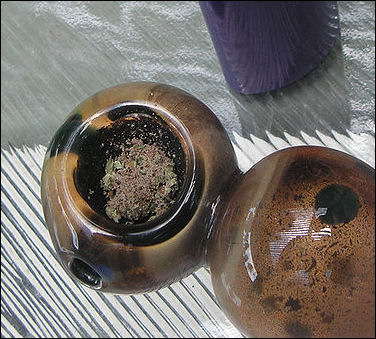
Kief The main types of cannabis products: 1) marijuana, the flowering heads and leaves of the cannabis plant; 2) buds, the resin-gland-rich flowering tops f the female plant; 3) sinsemilla, (meaning “without seed”), flowering tops absent of seeds as a result of being raised with no male plants present; 4) kief (kif) , a powder made up of resin glands produced by sifting buds and leaves; 5) hashish, made by pressing kief into blocks; and 6) hash oil, made by extracting or distilling the THC-rich parts of the plant. The leaves, stems and seeds, sometimes referred to as shake, or leaf, have little potency or value.
India has its own cannabis products and they provides a convenient model for the potency of different cannabis products. Bhang, the cheapest and least potent form, is produced from leaves, seeds and stems. It is sometimes smoked but is more commonly used in drinks made with almonds, milk and spices. Ganja, at least three or four times stronger than bhang, is prepared from flowering tops of the female plant. Charas, at least three or four times stronger than ganja, is pure resin.
Smoking THC-rich resins extracted from the cannabis plant is on the rise. People call this practice dabbing. These extracts come in various forms, such as: 1) hash oil or honey oil — a gooey liquid; 2) wax or budder — a soft solid with a texture like lip balm; and 3) shatter — a hard, amber-colored solid. These se extracts have become increasingly popular in the Europe and the United States, partly because they are very powerful and some can be painted on cigarettes and smoked in public without being detected. They can deliver extremely large amounts of THC to the body, and their use has sent some people to the emergency room. Another danger is in preparing these extracts, which usually involves butane (lighter fluid). A number of people have caused fires and explosions and have been seriously burned from using butane to make extracts at home. [Source: National Institute on Drug Abuse, National Institutes of Health, U.S. Department of Health and Human Services, December 2019]
A number of chemical relatives f THC have been developed. They have names like synhexyl, nabilone and levonatradol. Marinol is a synthetic form of THC sometimes prescribed as appetite stimulant and anti-emetic for chemotherapy patients. The problem with Marinol is that it can take up to two hours to take effect and it makes patient sleepy.
Chemical analysis of seized cannabis plants reveals the presence of tung oil and other impurities.
Marijuana
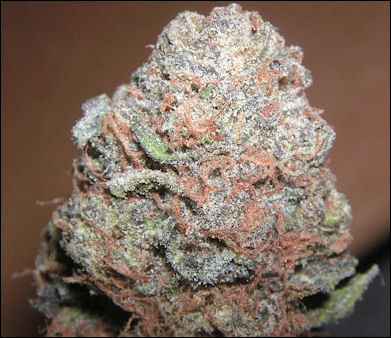
Purple Kush marijuana Marijuana (technically referred to as cannabis leaf and call cannabis in Britain and Europe ) refers to the dried leaves, flowers, stems, and seeds from the Cannabis sativa or Cannabis indica plant. The plant contains the mind-altering chemical THC and other similar compounds. Slang the terms for the drug include pot, weed, reefer, bud, herb, ganja, smoke, bhang. Among the terms used to describes hand-rolled marijuana cigarettes or various sizes are joints, reefers, and splifs. Heavy users are called potheads or simply heads. The word pot is derived from “potiguaya” , a Spanish word for marijuana leaves that have had their buds removed.
The best marijuana comes from the buds of the female plant. Bad stuff has a lot leaves and even seeds and stems in it. The word marijuana did not become widely used until the 1920s and 30s. It’s origin is not known. Some think it comes from “Mariguana”, and island in the Bahamas. Other say it come from “Maria Juana”, Spanish for Mary Jane and originated in Mexico.
The potency of marijuana is increasing. The THC content of most of the stuff — primarily from Mexico —sold in the streets of the United States in the 1960s was 1 percent to 2 percent. The THC content in the 1990s was 4 percent, with sinsemilla buds averaging 7.5 percent. The buds of some high grade varieties found today have a THC content of 20 percent to 30 percent.
In the 1960s much of the marijuana sold in the United States was the equivalent of Indian bhang. It was mostly leaves with a few buds and often many seeds and stems in it. These days it is mostly ganja of various potencies. In the old days Acapulco Gold, Panama Red, and Thai sticks, were some of the names used to describe potent, desired forms of marijuana. Their THC levels are relatively low compared to some of the varieties of skunk — the name used to describe potent forms of buds — found today. The stuff sold in the 1960s and 70s sold for around $20 an ounce and $300 a pound. The stuff sold today is often mostly buds. High quality bud, with a THC content of 30 percent, sells for $20 a gram and $8,000 a pound.
Hashish and Charas

Afghan hashish Hashish — often simply called hash and technically referred to as cannabis resin — is the concentrated extract of cannabis flower and plant. It is produced from resin and trichomes ( "hair"-like outgrowths from the cannabis buds) taken from of female cannabis sativa and cannabis indica plants, and compressed into bricks. The drug has been smoked for more than a thousand years in the Middle East, where, in some regions, it is still popular among Muslims who are not allowed to drink alcohol. It is more popular in Europe than in the United States and is smoked there mixed with tobacco in hand-rolled cigarettes with a cardboard filter. .
Hashish generally has a THC content of 7 to 20 percent. Some high quality hashish has a THC content of 28 percent. In contrast to cannabis leaf (marijuana), which can be found everywhere, cannabis resin (hashish) is produced mainly in a few countries in North Africa, the Middle East and Southwest Asia. Hashish comes in variety of colors: black, dark green, red or golden color. Most hashish has some plant material and color of the hashish often indicates what this plant material: low-quality green from leaves and trippier gold or red from gold or red flowers and trichomes. In Europe in recent years it has become common for hashish to be adulterated with various kinds of impurities such as Vaseline, beeswax or tree resin. .
Charas — which is sometimes referred to as hashish — is made by hand rubbing resin directly from the cannabis plant. It is produced primarily in India, Afghanistan and Nepal. Hash oil is a cannabis product that can be extracted from any part of the plant. It is made by boiling the cannabis plant in alcohol, filtering out the solids and evaporating out the water. Hash oils have a THC content of 20 to 45 percent. Some extremely potent versions are 78 percent THC.
Hashish varies in hardness and in texture from hard and bricklike, to soft and pliable to gooey High quality hashish is nearly 100 percent resin and is usually black and soft and can be easily molded with the fingers. All hashish can be softened by applying heat. Poor quality stuff is hard and brittle and has to be heated for some length of time to make pliable enough to easily break off.
See Separate Article HASHISH: HISTORY, TYPES AND PRODUCTION factsanddetails.com
Hemp
Hemp comes from the same cannabis plants that produces marijuana and hashish. It generally comes from plants with has negligible amounts of THC and doesn’t get people who smoke it high (although sometimes it can register false-positives on drug tests). By law in the United States, hemp must have THC concentrations of less than three tenths of one percent.
Hemp has been cultivated as a fabric since 2800 B.C. It is a very strong and durable material. Hemp fibers makes durable, breathable clothes. Environmentalist and farmers like it because it grows fast, is a renewable resources, requires little pesticides or herbicides and is an effective rotation crop. Hemp is sometimes used to describe the fibers of the Manila hemp (abaca), sisal, hequen, and sun hemp from Pakistan. These plants are related to true hemps but are different species.
Hemp fibers are made from the inner part of the plant's woody stalk. After the stalks have been harvested, they are let to rot so the outer bark can be removed easily. The stalks are then gather and passed through a hemp brake, in which rollers break the wood cords into short pieces and separates the long fibers.
In the 1970s, hemp cultivation was an important industry in Russia, India, Yugoslavia, Hungary, Romania and Italy. Today hemp is grown legally in abut 30 countries, including Canada and many European countries, with China controlling about 40 percent of the world market. Government officials in the United States oppose making hemp agriculture legal because of concerns that large hemp fields could be used to hide high-THC cannabis plants.
Use of Hemp
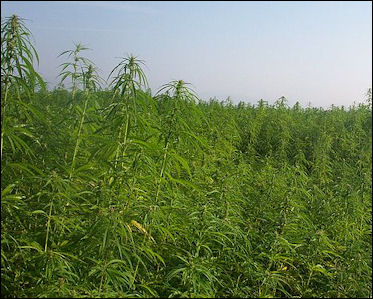
Industrial hemp Hemp has also traditionally been used in making twine, paper, carpets, mats, diapers, oakum, sandals, and coarse textiles. It is still used to make strong twine, high grade belting and webbing and packing materials. Textile manufactures like hemp because it resembles linen and doesn't need a lot of chemicals to produce. In the United States, it is used to make Patagonia hemp jeans. In Europe, it is mixed with lime plaster to make “bio-composite” interiors for Mercedes-Benzes.
Hemp was once the major of material used to make rope and coarse cloth. Over the last two centuries it has been replaced for ropemaking by abaca (Manila hemp) which is lighter and more resistant to water and for coarse cloth by jute. In the 20th century hemp, abaca and jute have all been replaced by synthetic fibers were invented.
Oil from the seeds (technically small hard fruits called akenes) are is used in artists, paints, linoleum and varnishes. The seeds themselves are found in bird seed and sometimes eaten as human food. Hemp-based livestock feed is used in Europe.
Hemp oil is high in protein, Vitamin E and two good fatty acids and is used to make soaps, cosmetics and food products in the United States such as Hemp body butter, Hempzel Pretezel, Hempseed Energy Bars, Healthy Hemple Sprouted Bread, milk-less cheese, veggie burgers and a variety of desserts. The oil is also used t make cosmetics and medicine such as Hempsters Zit Zapper.
In 2002, the Drug Enforcement Administration ordered all foods containing hemp to be taken of the shelves even amount of active ingredients found in them was less than the opiates found in a poppy seed bagels. Soaps, cosmetics and clothes made with hemp were allowed to be sold as long as their manufacturers could prove the hemp would not be absorbed into the body. The hemp industry in California, which is very big business, has been fighting the ruling. In 2004, the ruling was overturned by a federal appeal’s court and hemp-based foods were allowed to be sold.
In 2005, the feeding of hemp to livestock in Liechtenstein was banned on the insistence of Switzerland with which Liechtenstein has a customs pact after small amounts of THC found in the hemp plants found its way into the milk of Liechtenstein’s dairy cows although none was found in the meat of cattle that ate the feed.
Image Source: DEA (Drug Enforcement Administration)
Text Sources: 1) “Buzzed, the Straight Facts About the Most Used and Abused Drugs from Alcohol to Ecstasy” by Cynthia Kuhn, Ph.D., Scott Swartzwelder Ph.D., Wilkie Wilson Ph.D., Duke University Medical Center (W.W. Norton, New York, 2003); 2) National Institute on Drug Abuse, National Institutes of Health, U.S. Department of Health and Human Services; 3) United Nations Office on Drugs and Crime (UNODC) and 4) National Geographic, New York Times, Washington Post, Los Angeles Times, Wikipedia, The Independent, Times of London, The New Yorker, Time, Newsweek, Reuters, Associated Press, AFP, , Lonely Planet Guides, and various books and other publications.
Last updated April 2022
